Kathleen
Forum Replies Created
-
KathleenParticipantI appreciated the lists of Bird Academy's favorite plants for each of our ecoregions. I live in southeastern Michigan, so my ecoregion is #8 Eastern Temperate Forests. Trumpet Honeysuckle vine is one of the recommendations. I have a fence that is on the outskirts of my Hummingbird Courtyard area, so I'd be able to see hummingbirds at a vine on the fence, if I was sitting in the patio. I'm also very interested in the Highbush Blueberry shrub and Chokecherry shrub/tree recommendations. Will have to check into native plant nurseries in the area to see if they are locally available.
-
KathleenParticipantI actually started with a small garden for monarch butterflies, following the recommendations for my locale, as provided by the North American Butterfly Assn. It was so exciting when monarchs, as well as other butterflies came, that I expanded to create a large native prairie garden in a 300 sq ft gardening bed. It was large enough that I have some regrets I didn't just sow it with native prairie seed mixes. I had a color scheme in mind of purples, pinks, blues, and whites. So, I planted purple coneflowers throughout, with some purple poppy mallow, wild nodding onion, swamp milkweed, common milkweed, blue lobelia, blue indigo, ironweed, New England aster, dogbane, wild bergamot, foxwood beardtongue, pearly everlasting, wild strawberry, joe pye weed, prairie phlox, prairie dropseed grass, bluestem grass, indian grass, and side oats grama grass. Purple coneflowers are wonderful because they bloom a long time and multiply. They transplant well. I'm happy I did this color scheme, which is in full bloom now. There was another area that was more difficult in terms of landscaping, because I had to invent the garden beds. I finally realized it would be best as a courtyard. I created flowering hedges on three sides with borders of flowers in front and a circular garden in the center with a hummingbird feeder. I had a small patio made to look out on the courtyard. There's a secret garden feel to it that I love, which is nice variety to the prairie garden beyond and the open woodland look of the front yard. I still have lawn to get rid of in the front yard and got some good ideas from our class about native ground covers.in reply to: Gather Your Local Knowledge #826894
-
KathleenParticipantI have been gardening for wildlife for over 10 years, so I was already familiar with these 'keys to gardening for birds'. It's an ongoing process, though, so I am still getting rid of more and more lawn - and adding more and more native plants, improving biodiversity, along with vertical diversity. I inherited a lot of beautiful, very tall (90 ft!) mostly non-native pine trees and a few large native hickory trees - to which I've added smaller native trees, native shrubs, and a large native prairie garden. The smaller trees and shrubs created better vertical diversity. Hedges along the borders of property are called 'wildlife corridors' and I have worked on creating these, too, as they are also important to wildlife. My best success is probably my native prairie garden because it has so much biodiversity and prairies are so badly needed now in the midwest. I've learned to be more messy and appreciated the support about that in this lesson. It can be hard to be in the suburbs, where everyone else has such a different approach to landscaping. In terms of keeping birds safe, a tip I can share is that I did have a window that was hit by a bird and putting a feeder right in front of it, along with decals solved the problem. Decals can only last 3-4 months, though. 'Feather Friendly' has a 'Window Collision Tape' with a dot pattern that lasts 10 years!! If the view out the window is important, decorative film.com has vertical or horizontal stripes (Solyx SXBSFH) that are probably among the least distracting. Otherwise, one can have some arty fun with stained glass, window gem effects, or patterns (birds, snowflakes, etc).in reply to: Keys to Gardening for Birds #826885
-
KathleenParticipantI unfortunately have no oak trees, but I did save our neighbor's huge oak from being cut down! I was out in my garden and the workmen actually came over to ask me whether or not to cut it down! Amazing! I told them it was a very important tree for wildlife....and they didn't cut it down....One of those times I was in the right place at the right time :) The many huge pines that surround my home are not native, but they at least provide excellent shelter during the long, cold, midwestern winter. I learned from this lesson that my large native prairie garden is a great source of caterpillars for baby birds. My prairie garden has many native purple coneflowers, so it’s fun to see flocks of goldfinches descend on them for their seeds in the fall. I learned in this lesson that some of my practices as a gardener for wildlife are especially helpful to insects and invertebrates: 1) I have left a corner of the back yard wild (completely undisturbed) and take Christmas trees there, where I pile up large branches to decay. 2) I hold off on raking as long as possible. I was also pleased to learn that I can research nesting boxes and where to place them from Nest Watch on the Cornell Ornithology Lab website.in reply to: Give Birds What They Need #824945
-
KathleenParticipantI have been gardening for wildlife for over 10 years. It has been more and more fulfilling each year. I've been seeing a greater diversity, as well as greater numbers of birds as I improve the sanctuary. I have learned a great deal and continue to learn. I have created a hummingbird courtyard garden, a large native prairie garden and an open woodland look to the front yard. I am still working on getting rid of lawn in the front yard and adding native plants. I live in southeastern Michigan, so the red bud trees, red twig dogwoods, elderberry and serviceberry bushes that I had planted are native to my area. I planted large masses of wild geraniums and blue bells under a hickory tree and mayapples under pine trees. I planted a dozen purple coneflowers out in full sun around the mailbox. In particular, I’d like to get rid of the rest of the lawn and plant native groundcovers around the red bud trees and the berry bushes. I participated in Project Feeder Watch this past year, so I set out more bird feeders. I enjoyed working for PFW a great deal and see a lot more birds around our home. One of my favorite times was in late spring, with the stunning arrival of a small flock of Baltimore orioles in my back yard. Other highlights that stood out from the usual ‘backyard birds’ were a pileated woodpecker, pair of rose-breasted grosbeaks, and a pair of mallards. We have a small pond area that I’d like to make more attractive to the ducks, who unfortunately left after staying a few weeks in late spring. My favorite place to spend time is in the hummingbird courtyard. I love waking up in the morning with a cup of coffee, watching the hummingbirds!in reply to: Joys of Naturescaping #824328
-
KathleenParticipantI have taken classes in Photoshop, so editing is just something I enjoy a great deal that is not overly challenging. My classes in Photoshop were some time ago, though, and this was great review. Organizing photos is another matter. It's not that I have trouble organizing, it's that I procrastinate because I don't like to do it. Melissa's ideas for organization motivated me to take the time. I especially appreciated Melissa's encouragement to find ways to educate, arouse interest, and motivate people to take action for birds. I have been writing about my gardening for wildlife and the large sanctuary I've developed all around my home in the last 10 years. I begin with info about all the trees, bushes, flowering plants and how they are beneficial to wildlife - and I end with the wildlife that has been attracted and illustrations of my favorites. So far, I have my own color pencil drawings, but I would like to add my own photos, too. I had thought of this as a gift to family and friends, but I could also make it into a blog or powerpoint presentation. Melissa has motivated me to take that extra step in the future....
-
KathleenParticipantThis spring has been special because blue jays built a nest in a tall pine tree that was easily viewed from my kitchen window - and with binoculars, I was able to see the babies as well as the mother! So, I decided to photograph them for this homework assignment of a story in photos. I actually took eight photos for the story, but I'm submitting my favorite three. While photographing, I could see the importance of showing the habitat, rather than cropping closely around the birds. This was important with the first photo of the mother jay alone in her nest and then the second photo of the babies in the nest - safely surrounded by the pine tree. Then, I was very worried that the babies had fledged too early. I saw the empty nest and just one solitary baby bird up against a tree waiting. Later, I saw that the baby was hopping around the back yard and hopped onto a wheelbarrow, trying to fly. I'm including this photo, which is interesting because I had to take it looking into the light and the shape of the baby and pine boughs are silhouetted. I was able to use telephoto and keep a distance. Then, the baby hopped over and flew slightly up the stairs of the neighbor's house. He/she seemed afraid and didn't move for a long time, so I went out looking for the mother. I saw her up above in a tree and took a photo which shows nice backlighting again with the bird and foliage silhouetted against the sky. The last photo is of the mother and the baby on the stairs. The baby seems to be asking to be fed. I took the photo so the baby and the mother seem small compared to the fencing on the stairs. I unfortunately had to leave and when I returned, I searched for the baby and there was no sign. So, I can only HOPE that there was a happy ending to this and the baby was indeed able to fly! So this became


 a bittersweet story - caused me to realize how safe & snug the babies are at first in the nest and to feel with a pang just how big & scary the world may seem to a baby bird. But I was also somewhat reassured because I witnessed great dedication from the mother jay on the nest and she was right there for the baby jay who was out of the nest so young to explore the world...... in reply to: Practice Getting Creative and Telling Stories #820761
a bittersweet story - caused me to realize how safe & snug the babies are at first in the nest and to feel with a pang just how big & scary the world may seem to a baby bird. But I was also somewhat reassured because I witnessed great dedication from the mother jay on the nest and she was right there for the baby jay who was out of the nest so young to explore the world...... in reply to: Practice Getting Creative and Telling Stories #820761 -
KathleenParticipantI was attracted to this scene of Canada Geese because of the unusually sparkly water and the dramatically silhouetted design: the geese were swimming in alignment with one another and framed by branches, leaves & berries. I decided to crop it in an elongated composition to enhance the way the geese were swimming - and so that the geese are in the lower third of the composition.
 in reply to: Practice Crafting Great Bird Photos #814528
in reply to: Practice Crafting Great Bird Photos #814528 -
KathleenParticipantI'm sharing one of my favorite photos from my sit spot for Project Feeder Watch. It's not the most artistic, but it's the one I'm most excited about because it was the day nine Baltimore Orioles came to my bird feeding area - as well as a pair of Rose-breasted Grosbeaks! I was able to get three orioles in the foreground of this photo and the pair of grosbeaks in the hopper feeder further away. I've decorated all the shepherd's hooks that hold the feeders with red ribbons and placed large fake red flowers out in the garden to attract hummingbirds. With all the orioles I attracted, it seems likely they're attracted to red as well as orange! There is a large Flowering Quince nearby, which has been covered with orange-pink flowers. It's beautiful and much loved by all the birds for its shelter as well as its nectar. The Flowering Quince should be a great photo op and that will be one of my goals for the future. I also chose this spot as as sit spot because it is very near the large native prairie garden that I created - which borders a neighbors' wooded back yard. I put some feeders between the woods and the prairie and others between me and the prairie. While the woods is mostly deciduous, I have a stand of very large White Pines bordering the neighbor's woods. My sit spot is indoors and I watch birds from a window. Most birds don't notice me, but the feeder right in front of the window attracts finches and wrens who are scared by any movement. I will buy the camouflage drape that Melissa recommended to cover myself up when I sit there from now on. I've greatly enjoyed watching birds in this sit spot and look forward to taking better photos in the future with all the ideas and knowledge from this class!
 in reply to: Practice Gaining an Audience with Birds #813899
in reply to: Practice Gaining an Audience with Birds #813899 -
KathleenParticipantI am an artist who loves to draw and paint wildlife - and to go for hikes looking for wildlife. In spite of being a bit shy of technology, I attained proficiency in Photoshop. My goal now is to learn more about photography, but only to take better reference photos of wildlife for my art and personal interest. So, I have the the Canon Power Shot SX60HS and think it is probably ideal for someone like me. Since I am almost 70, I am concerned about ergonomics and bought a Black Rapid sling strap today for carrying my camera at the hip level - rather than hanging from the neck. I also recently bought a strap for my binoculars, which keep them close to my chest while hiking and readily accessible for use. It's spring now, with frequent rain, so I bought the OpTech rain cover Melissa recommended, too. I was surprised to learn at the camera store that this means I could take photos in the rain....I had assumed it was just to protect it :) I was very pleased to learn more about Macaulay Library and enjoyed the homework assignment. It's an interesting way to develop a sense of what one likes in artistic effects and to understand the technology better. I looked at Steven Mlodinow's beautiful photos of Sandhill Cranes because I hope to see them on my next hike. I loved the warm colors of the birds in the foreground - especially with the glow of the water and blurred reeds in the background. I also liked the composition and the arrested sense of movement. I enjoyed the fact there were other species present besides cranes and think I tend to be drawn more to scenes with an abundance of birds than solitary birds.in reply to: Practice Matching Your Gear to Your Goals #813681
-
KathleenParticipant
 I read about e-Bird sightings of the Common Merganser in a river at a large park in Ann Arbor (Southeastern Michigan). I had never seen one, but thought the male was stunning - with its large red beak, dark irridescent head & neck, black and white body and orange feet. So, I decided to research it and set out, hoping to find it. I have a beautiful new bird book, "Birds of North America", by the National Audubon Society. It has the unusual addition of conservation notes about every bird, which is important to me. I was interested that the Common Merganser is at the top of the aquatic food chain, meaning that its populations predict the health of their local habitat. Ann Arbor is known for its environmentalism, so the presence of mergansers is not surprising. I also read that Common Mergansers prefer wooded rivers, such as the one I hoped to find them in, and are often seen in flocks of 10-20. I read that they swim upstream and dive often for fish. So, I set off in search of Common Mergansers at the location they had been seen. As soon as I arrived at the river bank, I saw a beautiful male Common Merganser swimming and diving often. I'm sharing my favorite photo with you, which shows his colors the best. He also seemed to be playing at times - just splashing a lot - and even went skidding through the water at top speed! in reply to: Practice Understanding Birds for Better Photos #813310
I read about e-Bird sightings of the Common Merganser in a river at a large park in Ann Arbor (Southeastern Michigan). I had never seen one, but thought the male was stunning - with its large red beak, dark irridescent head & neck, black and white body and orange feet. So, I decided to research it and set out, hoping to find it. I have a beautiful new bird book, "Birds of North America", by the National Audubon Society. It has the unusual addition of conservation notes about every bird, which is important to me. I was interested that the Common Merganser is at the top of the aquatic food chain, meaning that its populations predict the health of their local habitat. Ann Arbor is known for its environmentalism, so the presence of mergansers is not surprising. I also read that Common Mergansers prefer wooded rivers, such as the one I hoped to find them in, and are often seen in flocks of 10-20. I read that they swim upstream and dive often for fish. So, I set off in search of Common Mergansers at the location they had been seen. As soon as I arrived at the river bank, I saw a beautiful male Common Merganser swimming and diving often. I'm sharing my favorite photo with you, which shows his colors the best. He also seemed to be playing at times - just splashing a lot - and even went skidding through the water at top speed! in reply to: Practice Understanding Birds for Better Photos #813310 -
KathleenParticipantI have spent the last ten years gardening for wildlife and transforming 1/2 an acre around my home into a wildlife sanctuary - which is one of the scientific prompts above for project ideas. I started with a small garden and native plants especially attractive to monarchs. I had a 'wow' moment when they first arrived, seemed to be dancing in delight around all the flowers, and then one monarch came careening right at me! It was so bizarre I entertained the idea for a moment that maybe just maybe he/she was thanking me! (LOL) More and more monarchs came that first summer and then I was amazed to discover cute little baby caterpillars all over the swamp milkweeds. I brought one in to raise it through chrysalis to adult butterfly in a terrarium. I had another 'wow' moment when I named him and released him into the sky. He kept flying around me in circles before leaving! So, that was it, I had a new passion, and now, 10 years later, the 1/2 acre around my home is radically better for wildlife. In particular, I have a large native prairie garden based on recommendations for southeastern Michigan by the North American Butterfly Association. In the beginning, I saw a lot more butterflies, but soon I noticed a lot more birds and backyard wildlife in general. All this led to another one of the science-based prompts listed above - participation in citizen science projects. I love counting birds for Project Feeder Watch and taking birding classes with the Bird Academy, as well. Last and not least, I'd like to thank Liz for a terrific class! Liz is a very gifted teacher - kind and motivating, with excellent skills and the ability to instruct very clearly. The class was very interesting and well organized. I'll be continuing on my own by finishing a journal of drawings and paintings of my backyard wildlife. I'm filling a 9x12 portfolio with 48 pages (each page has an acetate sleeve to insert art). After that, I hope to work on another journal - collecting poems and poetic prose about nature and doing illustrations.in reply to: Tips to Keep You Going #805749
-
KathleenParticipantAs a child, I spent summers in the country near Lake Michigan. I developed a real love of Nature and read a lot of Haiku. As a young adult, I enjoyed reading Thoreau and Emerson. When I retired, I started gardening for wildlife and reading about spiritual ecology. One of my favorite books is "Spiritual Ecology: The Cry of the Earth" by L. Vaughan Lee. Some of the books I've learned the most from are "Half-Earth: Our Planet's Fight for Life" by Edward O. Wilson, "Gaia's Garden" by Hemenway, and "Inheritors of the Earth" by C. Thomas. Some books about birds that I enjoyed the most are "Why Birds Sing" by Rothenberg, "The Gift of Birds" ed. Habegger, and "Gods of the Morning" by Lister Kaye.in reply to: The Power of Reflection #805552
-
KathleenParticipant
 Sorry, I can't find my first drawing. I'm sure, though, that I just drew the bird and branch the way I saw them. Since I am already a trained artist, there wasn't too much of a difference between the two drawings in terms of realism. I unfortunately haven't done much art at all in the last 10 years. I still can draw realistically, but I am less apt to experiment because I feel very out of practice. So, the difference in my case is that, after taking this class and starting to draw/paint again, I loosened up and started to feel more experimental again. With the warbler photo, I had fun changing the design of the branch and foliage. I liked the way the photo was more horizontal than a standard shape and decided to make my drawing in an even more elongated format - a little like an oriental drawing. in reply to: See How Far You’ve Come #805251
Sorry, I can't find my first drawing. I'm sure, though, that I just drew the bird and branch the way I saw them. Since I am already a trained artist, there wasn't too much of a difference between the two drawings in terms of realism. I unfortunately haven't done much art at all in the last 10 years. I still can draw realistically, but I am less apt to experiment because I feel very out of practice. So, the difference in my case is that, after taking this class and starting to draw/paint again, I loosened up and started to feel more experimental again. With the warbler photo, I had fun changing the design of the branch and foliage. I liked the way the photo was more horizontal than a standard shape and decided to make my drawing in an even more elongated format - a little like an oriental drawing. in reply to: See How Far You’ve Come #805251 -
KathleenParticipant
 in reply to: Filling Your Sketches with Color #805190
in reply to: Filling Your Sketches with Color #805190 -
KathleenParticipant
 I enjoyed this! I love seeing the Canada Geese at a park on a river where I live. This little painting is from one of my photos. I took some artistic liberties with colors. I decided to give everything a bluer, cooler tint - so I started with a blue tone to the white on the goose to take the edge off the ivory toned watercolor paper. Then, I added blue to the black for the head & neck and blue to a dark cool brown for the body. I decided to use the same Ultramarine Blue in the water as well, which was actually a Cerulean Blue in the photo. I neutralized the Ultramarine Blue with a yellowish orange so the water would recede and the goose would be more of the focus. For all this I worked wet on dry, but I wasn't sure if that was right - maybe I should have wet down the paper first for the water. There are some slightly mottled areas, but I got lucky and they look a little like ripples in the water (LOL). I worked wet on wet for the goose's reflection in the water, but then it wasn't dark enough, so I worked dry brush over it to create dark ripples in the water. It unfortunately lost some of the luminosity from wet on wet as a result, but I think it still looks somewhat like a reflection. in reply to: Getting Comfortable with Watercolor #803563
I enjoyed this! I love seeing the Canada Geese at a park on a river where I live. This little painting is from one of my photos. I took some artistic liberties with colors. I decided to give everything a bluer, cooler tint - so I started with a blue tone to the white on the goose to take the edge off the ivory toned watercolor paper. Then, I added blue to the black for the head & neck and blue to a dark cool brown for the body. I decided to use the same Ultramarine Blue in the water as well, which was actually a Cerulean Blue in the photo. I neutralized the Ultramarine Blue with a yellowish orange so the water would recede and the goose would be more of the focus. For all this I worked wet on dry, but I wasn't sure if that was right - maybe I should have wet down the paper first for the water. There are some slightly mottled areas, but I got lucky and they look a little like ripples in the water (LOL). I worked wet on wet for the goose's reflection in the water, but then it wasn't dark enough, so I worked dry brush over it to create dark ripples in the water. It unfortunately lost some of the luminosity from wet on wet as a result, but I think it still looks somewhat like a reflection. in reply to: Getting Comfortable with Watercolor #803563 -
KathleenParticipant
 This is not my first watercolor experience at all. I took a watercolor class during my Master's degree in drawing/(oil) painting, BUT that was 40 years ago! So, this is great review. I ran into trouble, though, because the set I ordered did not have black....but found some in a tube to use. I can see some of the colors looked good while mixing but needed some tweaking. For example, the cloud color should be a little more blue and the mountains should be more neutral. The scanning seems to be a problem for colors sometimes because the orange trees look purple-grey on the scan but look orange on my original paper. But it feels great to be doing watercolors again and I look forward to doing a watercolor bird! in reply to: Capturing Nature’s Color Palettes #803004
This is not my first watercolor experience at all. I took a watercolor class during my Master's degree in drawing/(oil) painting, BUT that was 40 years ago! So, this is great review. I ran into trouble, though, because the set I ordered did not have black....but found some in a tube to use. I can see some of the colors looked good while mixing but needed some tweaking. For example, the cloud color should be a little more blue and the mountains should be more neutral. The scanning seems to be a problem for colors sometimes because the orange trees look purple-grey on the scan but look orange on my original paper. But it feels great to be doing watercolors again and I look forward to doing a watercolor bird! in reply to: Capturing Nature’s Color Palettes #803004 -
KathleenParticipant
 I enjoyed this! I found myself thinking about the similarities of this bird to the Carolina wren - a bird I see often in my bird feeding area. It's one of my favorite birds because of its overall delicacy, perky tail and rich rust coloring. in reply to: Giving Your Drawings Depth #801597
I enjoyed this! I found myself thinking about the similarities of this bird to the Carolina wren - a bird I see often in my bird feeding area. It's one of my favorite birds because of its overall delicacy, perky tail and rich rust coloring. in reply to: Giving Your Drawings Depth #801597 -
KathleenParticipant
 I'm resubmitting this, because I don't think this registered the first time. This is a great exercise to shift to the right side of the brain and think less literally! I'm sure I also trained my eye to see proportions better, as I worked very slowly and thought as much as possible about shapes and relationships. I did find it a bit tedious, though. At one point, I even thought to myself, 'Wow, one of the stripes on the chest looks like a two headed prehistoric antelope!' (LOL) I was pleased when I finished it and turned it right-side up and it did look a lot like a sparrow! Great brainteaser and probably a really good anti-aging exercise for those of us over 65:) in reply to: Drawing What You See – Upside Down Drawing #801420
I'm resubmitting this, because I don't think this registered the first time. This is a great exercise to shift to the right side of the brain and think less literally! I'm sure I also trained my eye to see proportions better, as I worked very slowly and thought as much as possible about shapes and relationships. I did find it a bit tedious, though. At one point, I even thought to myself, 'Wow, one of the stripes on the chest looks like a two headed prehistoric antelope!' (LOL) I was pleased when I finished it and turned it right-side up and it did look a lot like a sparrow! Great brainteaser and probably a really good anti-aging exercise for those of us over 65:) in reply to: Drawing What You See – Upside Down Drawing #801420 -
KathleenParticipant

 I started with a quick sketch for the drawing of my dog. Then, I filled in the negative space and after that, I checked myself for proportions. I decided to just scribble to suggest the curly fur of my poodle and that was fun. in reply to: Getting the Proportions Right #800907
I started with a quick sketch for the drawing of my dog. Then, I filled in the negative space and after that, I checked myself for proportions. I decided to just scribble to suggest the curly fur of my poodle and that was fun. in reply to: Getting the Proportions Right #800907

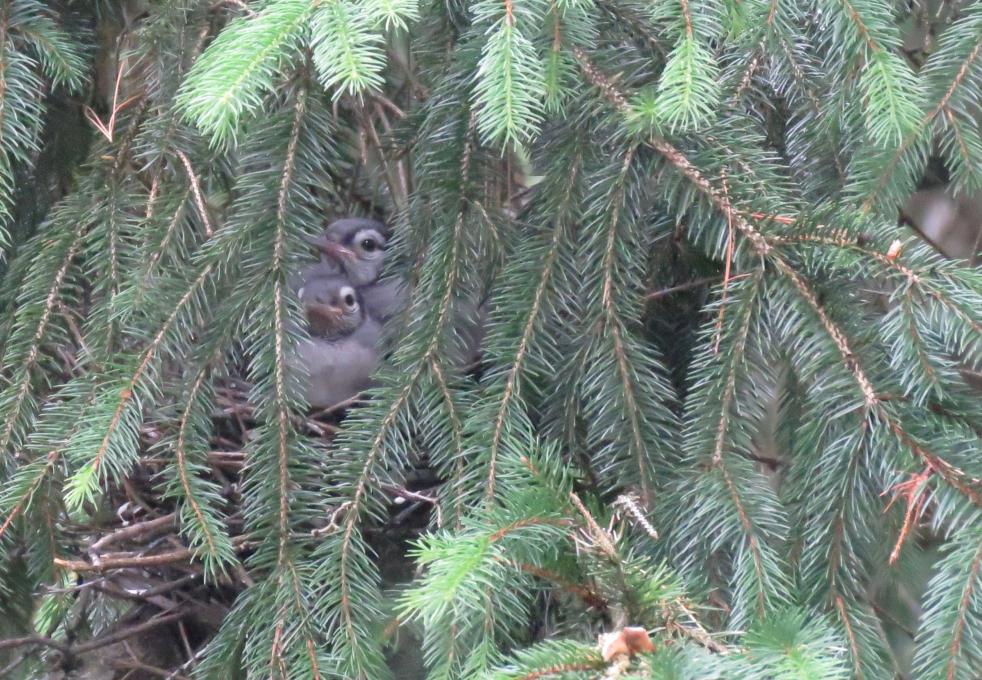
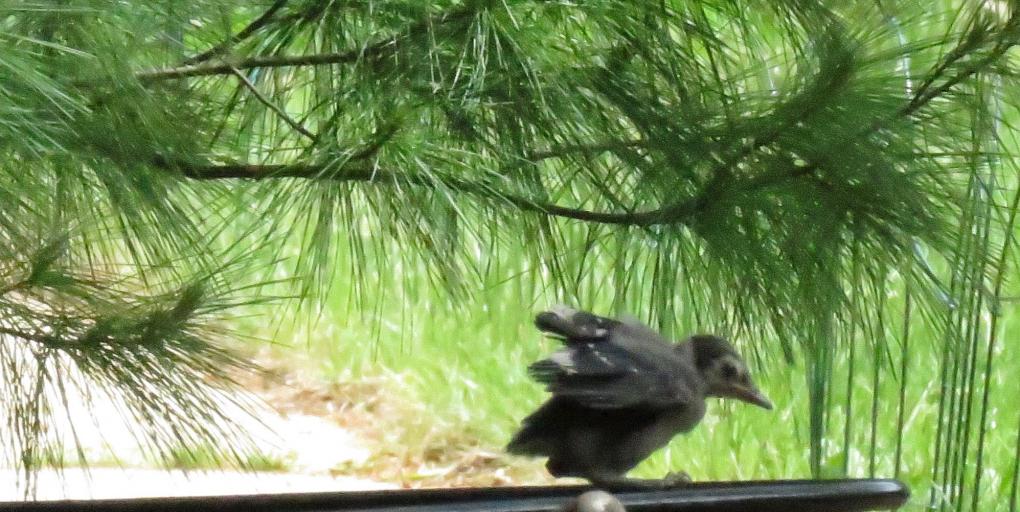 a bittersweet story - caused me to realize how safe & snug the babies are at first in the nest and to feel with a pang just how big & scary the world may seem to a baby bird. But I was also somewhat reassured because I witnessed great dedication from the mother jay on the nest and she was right there for the baby jay who was out of the nest so young to explore the world......
a bittersweet story - caused me to realize how safe & snug the babies are at first in the nest and to feel with a pang just how big & scary the world may seem to a baby bird. But I was also somewhat reassured because I witnessed great dedication from the mother jay on the nest and she was right there for the baby jay who was out of the nest so young to explore the world...... 
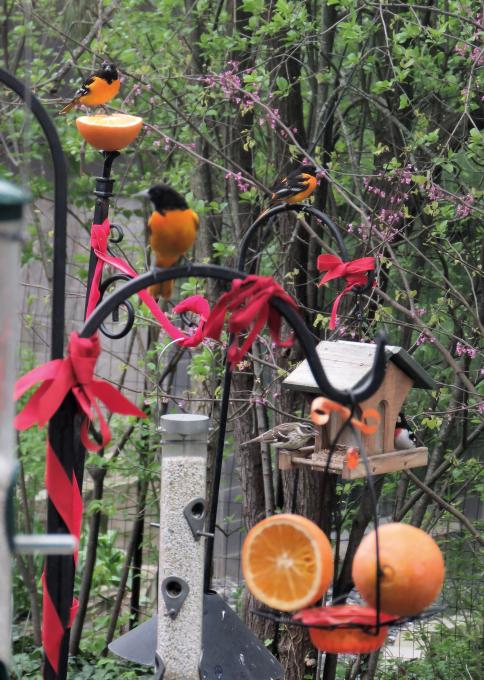
 I read about e-Bird sightings of the Common Merganser in a river at a large park in Ann Arbor (Southeastern Michigan). I had never seen one, but thought the male was stunning - with its large red beak, dark irridescent head & neck, black and white body and orange feet. So, I decided to research it and set out, hoping to find it. I have a beautiful new bird book, "Birds of North America", by the National Audubon Society. It has the unusual addition of conservation notes about every bird, which is important to me. I was interested that the Common Merganser is at the top of the aquatic food chain, meaning that its populations predict the health of their local habitat. Ann Arbor is known for its environmentalism, so the presence of mergansers is not surprising. I also read that Common Mergansers prefer wooded rivers, such as the one I hoped to find them in, and are often seen in flocks of 10-20. I read that they swim upstream and dive often for fish. So, I set off in search of Common Mergansers at the location they had been seen. As soon as I arrived at the river bank, I saw a beautiful male Common Merganser swimming and diving often. I'm sharing my favorite photo with you, which shows his colors the best. He also seemed to be playing at times - just splashing a lot - and even went skidding through the water at top speed!
I read about e-Bird sightings of the Common Merganser in a river at a large park in Ann Arbor (Southeastern Michigan). I had never seen one, but thought the male was stunning - with its large red beak, dark irridescent head & neck, black and white body and orange feet. So, I decided to research it and set out, hoping to find it. I have a beautiful new bird book, "Birds of North America", by the National Audubon Society. It has the unusual addition of conservation notes about every bird, which is important to me. I was interested that the Common Merganser is at the top of the aquatic food chain, meaning that its populations predict the health of their local habitat. Ann Arbor is known for its environmentalism, so the presence of mergansers is not surprising. I also read that Common Mergansers prefer wooded rivers, such as the one I hoped to find them in, and are often seen in flocks of 10-20. I read that they swim upstream and dive often for fish. So, I set off in search of Common Mergansers at the location they had been seen. As soon as I arrived at the river bank, I saw a beautiful male Common Merganser swimming and diving often. I'm sharing my favorite photo with you, which shows his colors the best. He also seemed to be playing at times - just splashing a lot - and even went skidding through the water at top speed! 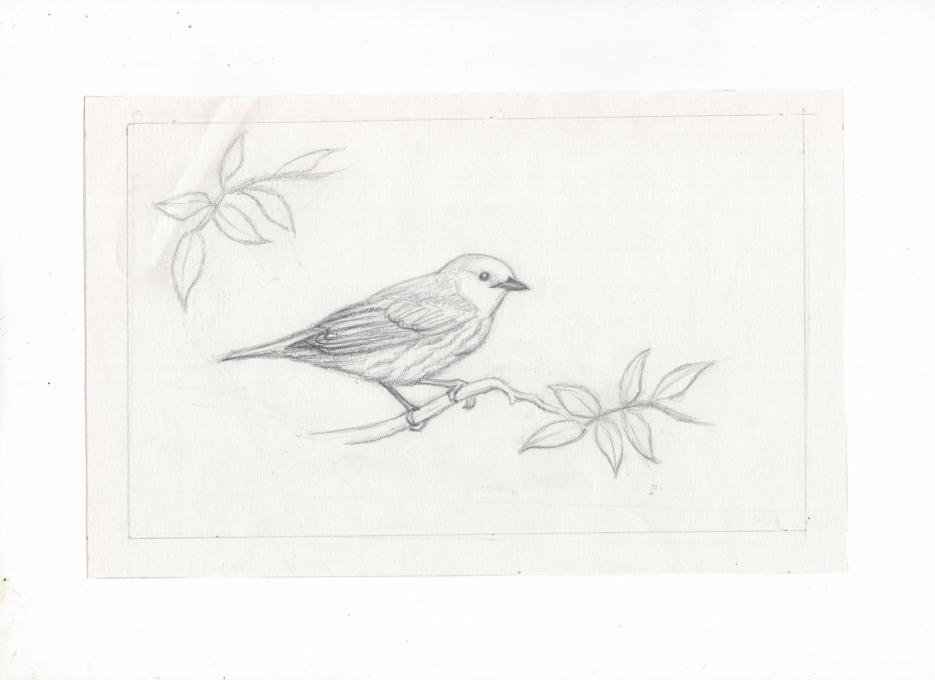 Sorry, I can't find my first drawing. I'm sure, though, that I just drew the bird and branch the way I saw them. Since I am already a trained artist, there wasn't too much of a difference between the two drawings in terms of realism. I unfortunately haven't done much art at all in the last 10 years. I still can draw realistically, but I am less apt to experiment because I feel very out of practice. So, the difference in my case is that, after taking this class and starting to draw/paint again, I loosened up and started to feel more experimental again. With the warbler photo, I had fun changing the design of the branch and foliage. I liked the way the photo was more horizontal than a standard shape and decided to make my drawing in an even more elongated format - a little like an oriental drawing.
Sorry, I can't find my first drawing. I'm sure, though, that I just drew the bird and branch the way I saw them. Since I am already a trained artist, there wasn't too much of a difference between the two drawings in terms of realism. I unfortunately haven't done much art at all in the last 10 years. I still can draw realistically, but I am less apt to experiment because I feel very out of practice. So, the difference in my case is that, after taking this class and starting to draw/paint again, I loosened up and started to feel more experimental again. With the warbler photo, I had fun changing the design of the branch and foliage. I liked the way the photo was more horizontal than a standard shape and decided to make my drawing in an even more elongated format - a little like an oriental drawing. 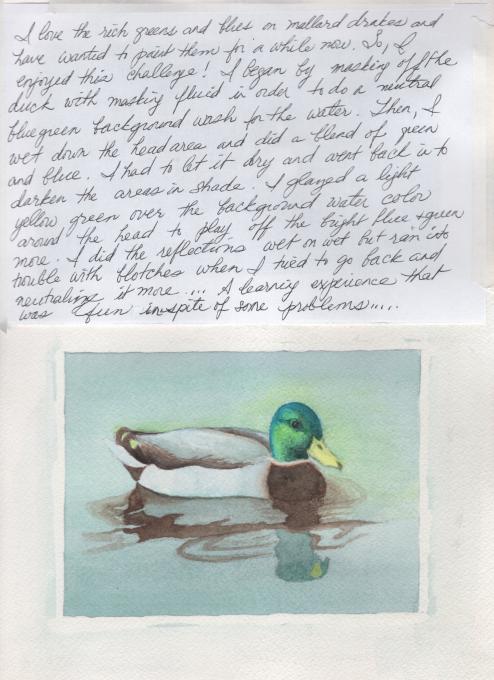
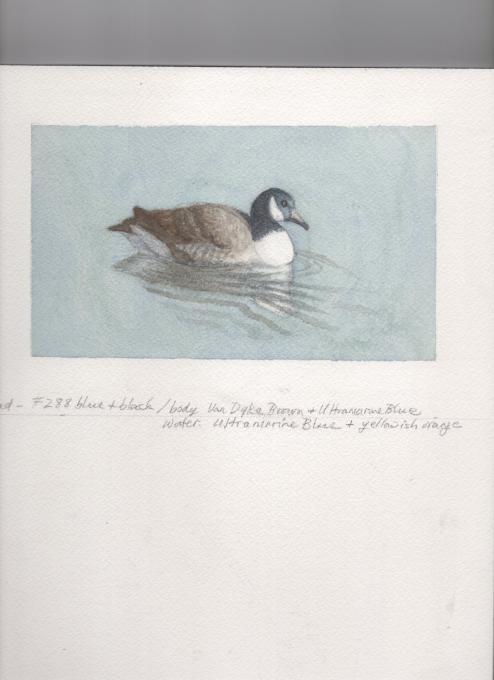 I enjoyed this! I love seeing the Canada Geese at a park on a river where I live. This little painting is from one of my photos. I took some artistic liberties with colors. I decided to give everything a bluer, cooler tint - so I started with a blue tone to the white on the goose to take the edge off the ivory toned watercolor paper. Then, I added blue to the black for the head & neck and blue to a dark cool brown for the body. I decided to use the same Ultramarine Blue in the water as well, which was actually a Cerulean Blue in the photo. I neutralized the Ultramarine Blue with a yellowish orange so the water would recede and the goose would be more of the focus. For all this I worked wet on dry, but I wasn't sure if that was right - maybe I should have wet down the paper first for the water. There are some slightly mottled areas, but I got lucky and they look a little like ripples in the water (LOL). I worked wet on wet for the goose's reflection in the water, but then it wasn't dark enough, so I worked dry brush over it to create dark ripples in the water. It unfortunately lost some of the luminosity from wet on wet as a result, but I think it still looks somewhat like a reflection.
I enjoyed this! I love seeing the Canada Geese at a park on a river where I live. This little painting is from one of my photos. I took some artistic liberties with colors. I decided to give everything a bluer, cooler tint - so I started with a blue tone to the white on the goose to take the edge off the ivory toned watercolor paper. Then, I added blue to the black for the head & neck and blue to a dark cool brown for the body. I decided to use the same Ultramarine Blue in the water as well, which was actually a Cerulean Blue in the photo. I neutralized the Ultramarine Blue with a yellowish orange so the water would recede and the goose would be more of the focus. For all this I worked wet on dry, but I wasn't sure if that was right - maybe I should have wet down the paper first for the water. There are some slightly mottled areas, but I got lucky and they look a little like ripples in the water (LOL). I worked wet on wet for the goose's reflection in the water, but then it wasn't dark enough, so I worked dry brush over it to create dark ripples in the water. It unfortunately lost some of the luminosity from wet on wet as a result, but I think it still looks somewhat like a reflection. 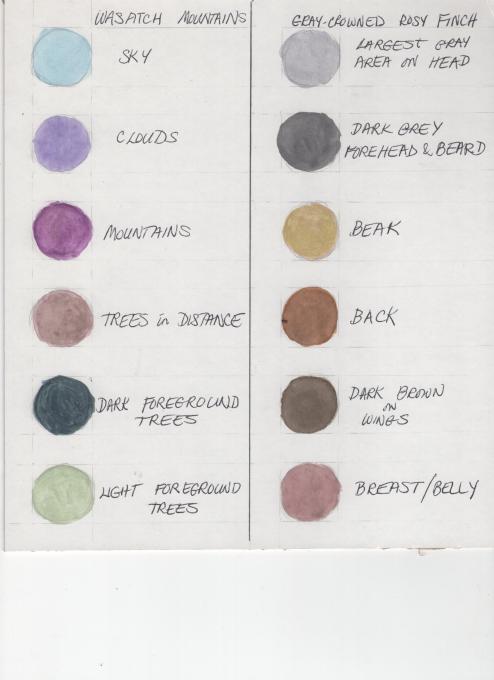 This is not my first watercolor experience at all. I took a watercolor class during my Master's degree in drawing/(oil) painting, BUT that was 40 years ago! So, this is great review. I ran into trouble, though, because the set I ordered did not have black....but found some in a tube to use. I can see some of the colors looked good while mixing but needed some tweaking. For example, the cloud color should be a little more blue and the mountains should be more neutral. The scanning seems to be a problem for colors sometimes because the orange trees look purple-grey on the scan but look orange on my original paper. But it feels great to be doing watercolors again and I look forward to doing a watercolor bird!
This is not my first watercolor experience at all. I took a watercolor class during my Master's degree in drawing/(oil) painting, BUT that was 40 years ago! So, this is great review. I ran into trouble, though, because the set I ordered did not have black....but found some in a tube to use. I can see some of the colors looked good while mixing but needed some tweaking. For example, the cloud color should be a little more blue and the mountains should be more neutral. The scanning seems to be a problem for colors sometimes because the orange trees look purple-grey on the scan but look orange on my original paper. But it feels great to be doing watercolors again and I look forward to doing a watercolor bird!  I enjoyed this! I found myself thinking about the similarities of this bird to the Carolina wren - a bird I see often in my bird feeding area. It's one of my favorite birds because of its overall delicacy, perky tail and rich rust coloring.
I enjoyed this! I found myself thinking about the similarities of this bird to the Carolina wren - a bird I see often in my bird feeding area. It's one of my favorite birds because of its overall delicacy, perky tail and rich rust coloring. 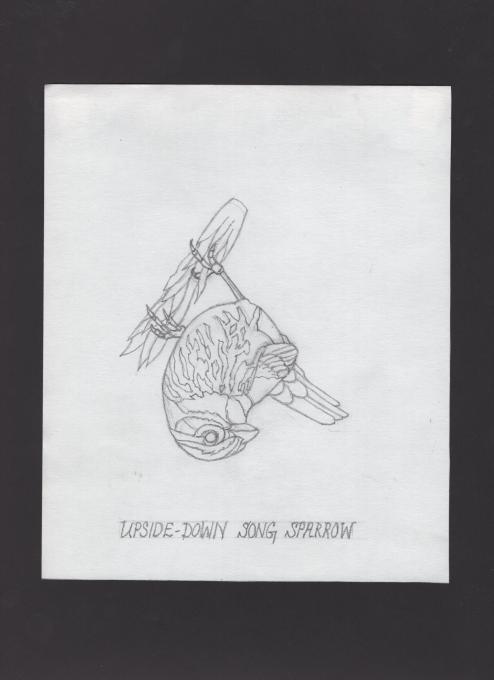 I'm resubmitting this, because I don't think this registered the first time. This is a great exercise to shift to the right side of the brain and think less literally! I'm sure I also trained my eye to see proportions better, as I worked very slowly and thought as much as possible about shapes and relationships. I did find it a bit tedious, though. At one point, I even thought to myself, 'Wow, one of the stripes on the chest looks like a two headed prehistoric antelope!' (LOL) I was pleased when I finished it and turned it right-side up and it did look a lot like a sparrow! Great brainteaser and probably a really good anti-aging exercise for those of us over 65:)
I'm resubmitting this, because I don't think this registered the first time. This is a great exercise to shift to the right side of the brain and think less literally! I'm sure I also trained my eye to see proportions better, as I worked very slowly and thought as much as possible about shapes and relationships. I did find it a bit tedious, though. At one point, I even thought to myself, 'Wow, one of the stripes on the chest looks like a two headed prehistoric antelope!' (LOL) I was pleased when I finished it and turned it right-side up and it did look a lot like a sparrow! Great brainteaser and probably a really good anti-aging exercise for those of us over 65:) 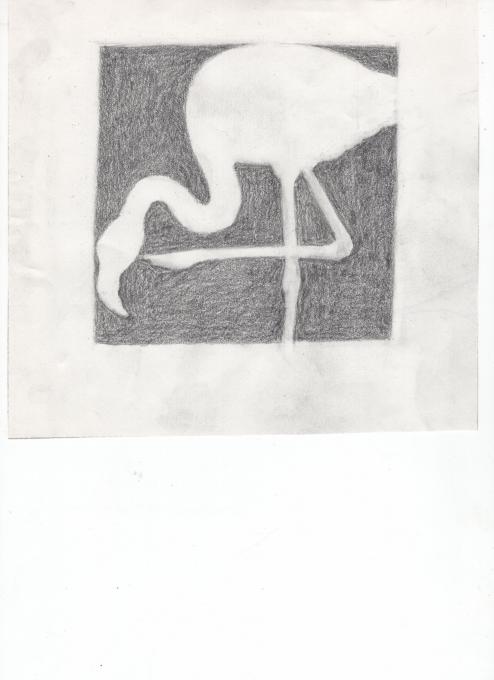
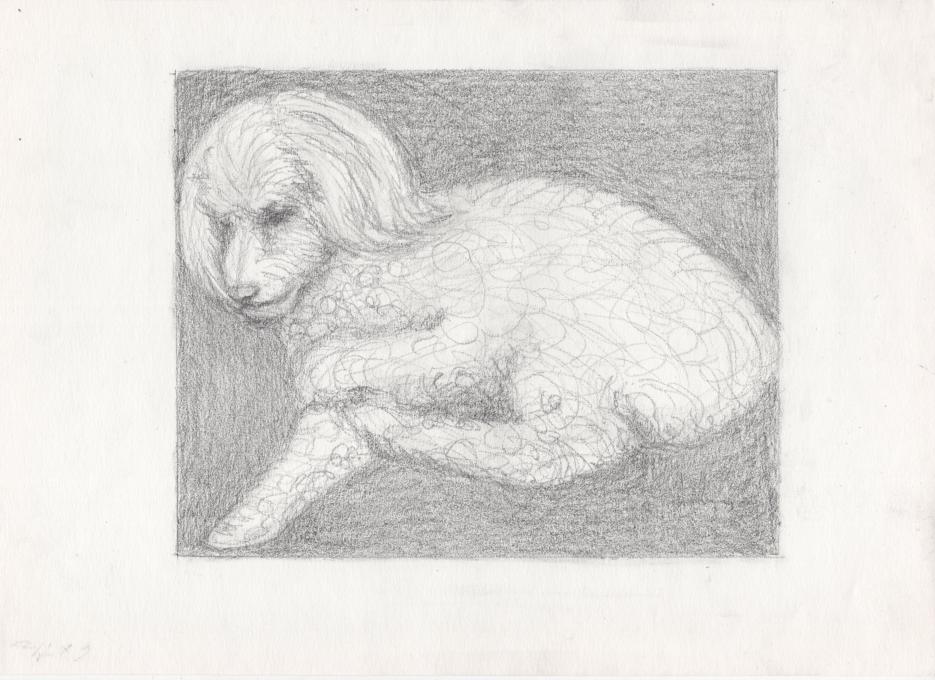 I started with a quick sketch for the drawing of my dog. Then, I filled in the negative space and after that, I checked myself for proportions. I decided to just scribble to suggest the curly fur of my poodle and that was fun.
I started with a quick sketch for the drawing of my dog. Then, I filled in the negative space and after that, I checked myself for proportions. I decided to just scribble to suggest the curly fur of my poodle and that was fun.